Shy of media attention, Kirtipur, the historical fourth kingdom has its share of stories to tell.
A troop of battle-weary soldiers, khukuris in hand, formed their regiment lines along the banks of the Bagmati River and faced the hill rising above them to the South. Clad in chain mail and carrying shields, the men marching up the steep incline, following their king, Prithvi Narayan Shah, only 34 years old at the time, and his top general, Kalu Pandey. Shah, who would later conquer and unify the territories that constitute modern day Nepal, must have been unimpressed by the small, unassuming fortified city at the top of the hill.

As they approached the stone wall, the general barked his orders. No sooner did the men fall into their positions that a volley of arrows and spears rained down from behind the embankment. Scattering under the heavy fire, the soldiers were no match for the villagers’ army hunkered down on the other side. The day was December 4, 1757, and before it was over, the imposing Gorkha army would lose 400 men, including their general, and the Shah king himself would barely escape with his life.
Today, I imagine the dejected king retreating down the hill as I cling to the back of my friend Raj’s motorcycle, terraced fields whizzing by on either side of the narrow road. We are following the Bagmati River south and up to the base of Kirtipur’s hill, where the crumbling remnants of the old walls mark the beginning of the city.
Initially, this short day trip was born out of our collective epiphany that many people living in the Kathmandu Valley have never been to Kirtipur, despite its proximity and historical legacy. Out of the four antiquated kingdoms of the valley—Kirtipur, Bhaktapur, Lalitpur (Patan), and Kantipur (Kathmandu)—Kirtipur, far and away the smallest, is the only one that remains relatively untouched by tourism or development.
 Swerving around a tight bend in the road, Kirtipur suddenly rises before us, its pointed roofs poking into the morning sky. Although we’re only 5km from downtown Kathmandu, we’ve already climbed high above the ruckus of the city streets below. The hill itself, covered with houses stacked precariously on top of each other, is accentuated at the top by the terraced roofs of a temple. As we ascend higher, the concrete houses are soon replaced by traditional Newari homes--rectangular mud and brick buildings topped with tiled roofs.
Swerving around a tight bend in the road, Kirtipur suddenly rises before us, its pointed roofs poking into the morning sky. Although we’re only 5km from downtown Kathmandu, we’ve already climbed high above the ruckus of the city streets below. The hill itself, covered with houses stacked precariously on top of each other, is accentuated at the top by the terraced roofs of a temple. As we ascend higher, the concrete houses are soon replaced by traditional Newari homes--rectangular mud and brick buildings topped with tiled roofs.
There are only two attractions that regularly draw outsiders up to the top of Kirtipur, and both are temples. The three-roofed Bagh Bhairav temple dates to the 11th century and sits in an open courtyard full of smaller shrines and temples. When Kirtipur eventually fell to the armies of Prithvi Narayan Shah, after his third offensive, the shields and swords of the defeated Kirtipuris (locals of Kirtipur) were stowed in the third floor of this temple, where they still gather dust today.
A couple of hundred meters further up the hill, seemingly resting on its apex, is the Uma Maheshwar temple. Dismounting our bike, Raj and I join a handful of tourists climbing the path up to the temple. Once through the gate, the view opens up to a 360 degree panorama of the Kathmandu Valley. The tourists snap a few photos, then turn and walk down the steps and down the hill.
The view itself is worth the trip, but Raj and I are interested in getting a little more historical context on the city. Descending back down the path, I follow my friend through winding backstreets swept clean and lined with little, blue trash bins. While there are a few kids kicking a football around, most people seem to be busy with work. Women hunker down over their handlooms inside hobbit-sized rooms, while others spread grain out with their feet on large Newari mats. Raj approaches a woman stringing red chili peppers from a window as if they were Christmas lights, but she says she doesn’t speak much Nepali, only Newari.
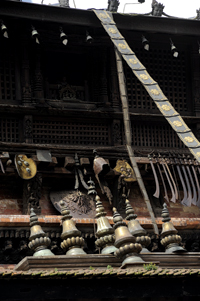 I find myself wondering how a place so close to Kathmandu can remain so untouched by the city below. That’s not to say there aren’t plenty of people riding sleek new motorbikes or talking on expensive mobile phones. But compared to just down the hill, where concrete buildings and lines of traffic constitute the scenery, Kirtipur feels like another world. In fact, it is easy to imagine that not much has changed here since the first outsider, the Shah king, invaded the place in the 18th century.
I find myself wondering how a place so close to Kathmandu can remain so untouched by the city below. That’s not to say there aren’t plenty of people riding sleek new motorbikes or talking on expensive mobile phones. But compared to just down the hill, where concrete buildings and lines of traffic constitute the scenery, Kirtipur feels like another world. In fact, it is easy to imagine that not much has changed here since the first outsider, the Shah king, invaded the place in the 18th century.
After consulting a few locals who do speak Nepali, we stop by a small fabric store to talk with 59 year-old Bhim Kumar Rajbhandari, a smartly dressed man sitting cross-legged in the middle of his shop. Although he denies any sort of title other than shopkeeper, other Kirtipuris describe Rajbhandari as a sort of informal folk historian.
“I don’t know how far back my family has been living in Kirtipur,” he tells my friend and I, “I can count back maybe ten generations, then I lose track.”
I ask him how he feels about the Shah king, the man his forefathers fought off to protect their homeland. “Prithvi Narayan Shah…he was a great man. If he hadn’t come, we wouldn’t be able to say we’re proud to be Nepalis. There would be no Nepal,” he says, then pauses, “But the third time he attacked…there was foul play.”
Rajbhandari relates a story told to him by his father about how, after failing to conquer Kirtipur on two separate attacks, Prithvi Narayan Shah retreated to Nuwakot, an area just outside of the valley. Seeking refuge in a local’s house, the king was offered dinner and a bed by a woman who didn’t know he was the king from Gorkha. Upon being served a platter of steaming rice, the King dipped his hand into the middle of the plate.
Yanking his burned hand back from the rice, his hostess scolded him. “You’re as foolish as Prithvi Narayan Shah,” she said, still unaware of his identity. Interested and caught off guard by her comment, the king asked her to elaborate on her comparison.
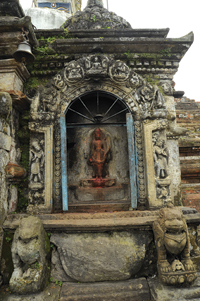 “Because, like you with your rice, the king is trying to defeat the walled city of Kirtipur by attacking it head on, aiming for the middle. You try to eat hot food from the middle of the plate, but it is better to eat a little, very slowly, from the around the edge,” she explains.
“Because, like you with your rice, the king is trying to defeat the walled city of Kirtipur by attacking it head on, aiming for the middle. You try to eat hot food from the middle of the plate, but it is better to eat a little, very slowly, from the around the edge,” she explains.
According to Rajbhandari, this was all the inspiration Prithvi Narayan Shah needed. Over the ensuing nine months, his troops encircled Kirtipur and formed a blockade. The Gorkha armies cut the city off from the trade routes around the valley and those running from India to Tibet, “until not a single grain of rice was left,” he says.
Once the city surrendered, so the history books read, the Shah king cut off the nose and lips of every man in Kirtipur. But Rajbhandari claims this popular story is a product of misinterpreted history.
“After their defeat, the Kirtipuris were ashamed. They used the phrase ‘Nakh katnu,’” he says. In Nepali, the phrase is used to express shame. Literally translated, it means to cut your nose. According to Rajbhandari, British explorers and soldiers in Nepal took the words literally, when they recorded the history of the Gorkha army’s conquest of the Kathmandu valley. In reality there was no mutilation, he claims.
Regardless of the historical proof supporting his stories, Rajbhandari is excellent at telling them. However, he informs us, if we want a real historian, we should go meet Sukha Sagar Shrestha, a local archeologist who lives just down the hill.
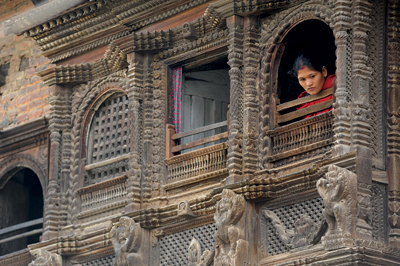
There are essentially two Kirtipurs: Kirtipur the historical city at the top of the hill, and Kirtipur the municipality. The municipality is home to roughly 50,000 people and includes the area of Chobar and a few neighboring villages, as well as the old city on top of the hill. Tribhuvan University, the first university established in the Kathmandu Valley, was built in Kirtipur municipality, below the old city, in 1959. Sukha Sagar Shresta’s house is located near the base of the hill, where the old Kirtipur meets the new Kirtipur.
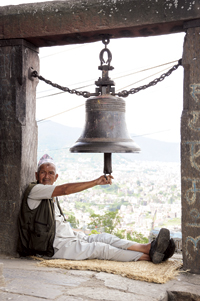
Shrestha, a wiry middle-aged man in matching trousers and shirt, has been an archeology fanatic since his days as a young schoolboy in Kirtipur. His studies have taken him all over Nepal, but he tends to spend most of his time now in his cluttered living room, which doubles as his library. A sofa against the far wall is stacked high with aging documents and bound pamphlets, many of which are his own work. Squeezing onto a bench, one of the few flat surfaces not covered with books, I ask Shrestha, in English, his opinions of Prithvi Narayan Shah and the historical legacy of Kirtipur.
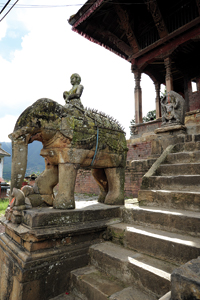
“Unifier or invader--it’s the words we use that make a man good or bad,” Shrestha says with a wry grin, “But the king and his army certainly weren’t the last outsiders to come to Kirtipur.”
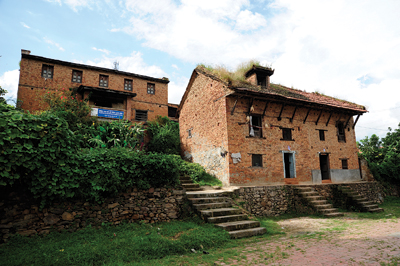
Indeed, Kirtipur municipality has seen a surge in growth lately, comparable even to Kathmandu and Patan. The most recent influxes have been students and professors, many of whom find cheap housing down below the hill near TU’s campus. These new Kirtipur residents have earned the area a reputation as a bastion of intellectualism. Protests initiated by youth and others associated with the university played major roles in the democracy movements of 1990 and 2006. But up the hill, past bits of the old city wall, Kirtipur proper has remained untouched. Or, almost untouched, Shrestha says.
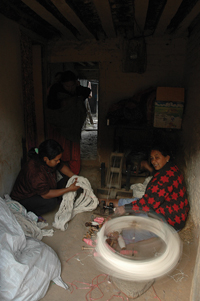 “Many of us used to be land owners from the same Newari caste of farmers,” Shrestha explains, “But over the last few decades, everyone has sold their land to the university and other developers.”
“Many of us used to be land owners from the same Newari caste of farmers,” Shrestha explains, “But over the last few decades, everyone has sold their land to the university and other developers.”
While this hasn’t physically affected the old city, it has come at a cost, Shrestha says. In 2010, Kirtipur residents padlocked the Central Department of Education of Tribhuvan University. The locals demanded that TU compensate them for the land the school bought in 1956, three years before the school was built. The Kirtipuris wanted TU to stand by a previous agreement ensuring that 40% of university employees would be hired from the local population. But to Shrestha, economic woes are only part of the issue.
“Many archeological sites have been lost in this whole development process,” he explains, picking up a manila folder and showing us a faded black and white photo. The image is too blurry to make out, but it appears to be a small mound of earth in a field.
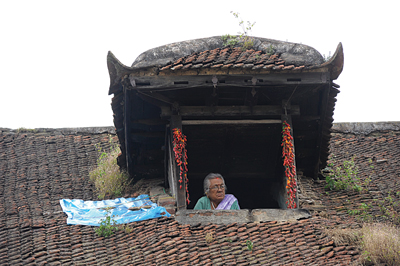 Much of the fighting during the first two battles with the Gorkhalis took place on the flat ground below the hill, where the university was built, Shrestha says. “Soldiers didn’t always have time to cremate the dead, so they buried them with candlewicks in their mouths.” The candlewick acted as a substitute for cremation, and allowed the body to be burned and purified in the next life.
Much of the fighting during the first two battles with the Gorkhalis took place on the flat ground below the hill, where the university was built, Shrestha says. “Soldiers didn’t always have time to cremate the dead, so they buried them with candlewicks in their mouths.” The candlewick acted as a substitute for cremation, and allowed the body to be burned and purified in the next life.
“20 years ago, there were many burial mounds down there,” he explains. “Unfortunately now, with immigration and construction, there are only a few left. TU’s College of Education was built on top of a particularly large grave.” Graves aren’t a common site in Kathmandu, especially 250 year old graves. Raj has work in the morning, so I decide to come back tomorrow by myself to see what I can find.
 By the time I pull up in front of the library at Tribhuvan University the next evening, the doors are about to close. The few students mingling outside aren’t too familiar with any burial mound in the area, but they introduce me to the library’s guard, who is from Kirtipur.
By the time I pull up in front of the library at Tribhuvan University the next evening, the doors are about to close. The few students mingling outside aren’t too familiar with any burial mound in the area, but they introduce me to the library’s guard, who is from Kirtipur.
Late afternoon quickly turns into evening as we ride up a winding path to the base of the hill. This time, rather than ascending to the city, we round a corner and park our bikes in front of a shop. A muddy stone path leads down to a small stupa erected by a river.
My sparse Nepali isn’t enough to ask the guard any significant questions about the four concrete edifices near the stupa that he points to, so I walk down for a closer inspection. Apparently still in the process of being built, the gazebo-shaped structures have no inscriptions or markings except for a little red vermillion powder left from a puja ceremony. Two men pass by on their way to the stupa. Just to make sure I’m in the right place, I ask about the graves. They point to the concrete markers, just as the security guard had done, and continue walking.
The sun is nearly down. Other than a few kids throwing rocks off a nearby bridge, the only creatures around are a herd of water buffalo contently grazing on the long grass sprouting near the river bank. Like the city on top of the hill, the graves seem to be relatively unnoticed, even by the buffalo, and I get the notion that some in Kirtipur would like to keep it that way.









